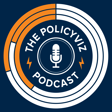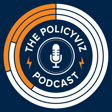
Visual Narratives: The Art and Craft of Data with Federica Fragapane
Welcome to Season 11 of the PolicyViz Podcast! After a relaxing summer full of travel and reading and fun, I’m ready to kick off a whole new season of the show. To kick off this season, I’m excited to be joined by Federica Fragapane, an independent designer known for her intricate and beautiful data visualizations. Our conversation delves into her creative process, the tools she uses, and where she finds inspiration. Fragapane, with a Master’s degree in visualization design and experience at Accurat Studio, integrates data into her bespoke visualizations that convey deeper narratives, particularly human experiences and environmental issues. She prefers organic shapes to reflect the living presence behind data, emphasizing beauty, context, audience, and accessibility.
Keywords: data, data visualization, flourish, graphic design, how to, information design, graphic design tutorials, graphic design portfolio, graphic design course, online learning, graphic design photoshop, graphic design trends 2024, how to draw, data scientist, Federica fragapane, accurat, AccessibilityInDesign, EngagingVisuals, Inspiration, DataNarratives, VisualizationDesign, InstagramPortfolio, BehancePortfolio, mathematics, Al, machine learning
Subscribe to the PolicyViz Podcast wherever you get your podcasts.
Become a patron of the PolicyViz Podcast for as little as a buck a month
Check out Federica's Behance portfolio and follow her on Instagram.
Follow me on Instagram, LinkedIn, Substack, Twitter, Website, YouTube
Email: jon@policyviz.com

